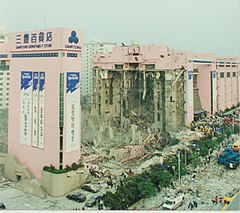 The department store after the collapse | |
| Date | June 29, 1995 |
|---|---|
| Time | 5:52 p.m. KST |
| Location | Seoul, South Korea |
| Cause | Structural overload, punching shear |
| Deaths | 502 |
| Non-fatal injuries | 937 |
| Suspects | Lee Joon Lee Han-sang |
| Verdict | Guilty |
| Convictions | Criminal negligence resulting in death (Lee Joon) Corruption, accidential homicide (Lee Han Sang) |
| Sentence |
|
On June 29, 1995, the Sampoong Department Store (Korean: 삼풍백화점; Hanja: 三豐百貨店) in Seoul, South Korea, collapsed due to a structural failure. The collapse killed 502 people and injured 937, making it the largest peacetime disaster in South Korean history. It was the deadliest non-deliberate modern building collapse until the 2013 Rana Plaza factory collapse in Bangladesh.[1][2]
Construction on the store began in 1987 and was completed in 1990. The company initially contracted to build the structure withdrew after the chairman of Sampoong Group's construction division, Lee Joon, demanded changes to the concrete support columns that introduced structural concerns. Lee Joon ultimately used his own company to complete construction. Investigators blamed the collapse primarily on the column specifications which were incorrect for a flat-slab building design.
On December 27, 1995, Lee Joon was convicted of criminal negligence and sentenced to 10 years and 6 months imprisonment. His sentence was later lessened to 7 years and 6 months on appeal. His son, Lee Han-sang, was convicted of corruption and accidental homicide and sentenced to 7 years imprisonment. Additionally, two city planners from the Seocho District of Seoul were convicted of taking bribes.[3]: 112
- ^ "Bangladesh building collapse death toll passes 700". BBC News. May 7, 2013. Retrieved May 7, 2013.
- ^ "<삼풍참사 20년> ① 그날 삼풍백화점에선 무슨 일이 있었나" [<20 years of Sampoong disaster> ① What happened at Sampung Department Store that day?] (in Korean). Yonhap News Agency. June 28, 2015.
- ^ Cite error: The named reference
Wearne 2000was invoked but never defined (see the help page).